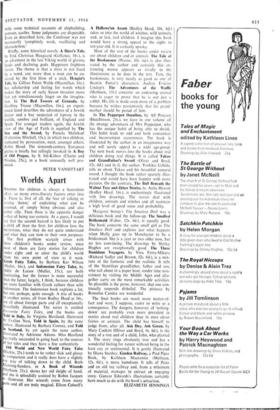Ages Past
THOUGH many may still leave school hating history almost as much as they hate poetry, there is less excuse. More imagination is being used on historical books for children about nine to twelve, without condescension, as these volumes show. Respect for truth is very proper in a historian, observed Jane Austen, aged twelve. The 'Jackdaw' Series (Cape, 1 ls. 6d. each) is outstanding. Encased in professional. looking files are contemporary documents— diaries, letters, maps, pictures, telegrams, photo- graphs, narration, together with intelligent and intelligible modern comment. The latest are Sarajevo, 1066, The Civil War, Early Trade Unions, The Peasants' Revolt, Agincourt (with both an English and a French account). Fac- similes include Charles's order for the impeach- ment of the Five Members, the Anglo-Saxon Chronicle's record of Hastings, press cuttings of 1914, fourteenth-century art, everything short of an LP of Kitchener singing 'Oh, What a Lovely War!'
Cassell's excellent 'Caravel' books (25s. each) discuss a key figure or situation with sensible text and a mass of varied illustrations, keeping a fair balance between heroes and their era. New additions, The Universe of Galileo and Newton and Leonardo da Vinci, are written with techni- cal insight and psychological perception. Leonardo is liable to be praised too recklessly, here Jay Williams, with many reproductions from his sketchbooks and notebooks, assesses more soberly his achievements, possibilities, failures. 'Tell me if anything at all was done,' Leonardo wrote, at the end.
Warrior and Soldier 449-1660, by A. V. B. Norman and Don Pottinger (Weidenfeld and Nicolson, 25s.) is a serious study of the develop- ment of English arms, tactics, commissariat, with plenty of minor details. In 134-6, chickens were two a penny, a fighting earl was paid 6s. 8d. a day. The evolution of armour is traced meticu- lously. Chanfron; ailette; ventail, hauberk. . . the language is as lulling as old cricket scores: Grace, caught Flowers, bowled Midwinter 99. Bristol, Sea-Port City, by Martin Ballard (Con- stable Young Books, 21s.), takes Bristol (Brig- stow, Place of the Bridge) from the first mention of a church, AD 804, to the Concord and com- prehensive schools, by way of pilgrimages, slaves, tobacco, Cabot and Frobisher, Rupert, Wesley, Brunel, Wally Hammond, Bevin : the cholera, the effect of London policies towards Spain, Monopolies, America, while The Mer- chant Navy, by Victor G. Ambrus (0.U.P., 17s. 6d.), is for younger readers, short and colourfully illustrated. The slave trade is ignored, but Plimsoll is rightly set alongside Drake and Cook. The point is made about the deterioration of shipbuilding and seamanship caused by Navi- gation Laws and monopolies.
The same age-group may enjoy Horses of Long Ago, by Dahlov Ipcar (Whiting and Wheaton, 18s.). Simple text and fine drawings• trace the horse from fox-sized Eohippus of fifty million years ago to its taming about 2500 se, then to the modern breeds, a chronicle of Egyptian charioteers, Persian mail riders, Assyrian cavalry, the influence of shoe, saddle, stirrup, horse-collar. It is claimed that, against the Romans, the British rejected riding, believing in the magical effect of soil upon feet. The Norman Invasion, by S. E. Ellacott (Abelard- Schuman, 18s.), usefully surveys Saxon, Danish and Norman rule preceding the Conquest (the Viking contribution is apt to be overlooked), a description of the campaign and its aftermath, with some technical accounts of shipbuilding, armour, castles. Some judgments are disputable. Even as described here, the Confessor was not necessarily 'completely weak, vacillating and characterless.'
Briefly, some historical novels. A Slave's Tale, by Erik Christian Haugaard (Gollancz, 18s.), is an adventure in the late Viking world of gloomy feuds and declining gods. Happiness frightens slaves. The theme is that a slave is not freed by a word, any more than a man can be en- slaved by the first blow of a stick. Hengist's Tale, by Gillian Paton Walsh (Macmillan, 16s.), has scholarship and feeling for words which makes the story of early Saxon invasion move fast yet simultaneously linger on the imagina- tion. In The Red Towers of Granada, by Geoffrey Trease (Macmillan, 16s.), an experi- enced hand describes the adventures of a Jewish doctor and a boy suspected of leprosy in the worlds, sombre and brilliant, of England and Spain. For younger readers again, the Jewish view of the Age of Faith is supplied by The Star and the Sword, by Pamela Melnikaff (Vallentine Mitchell, 15s.), in which two children, orphaned by persecution, meet, amongst others, Robin Hood. The sixteenth-century European ghetto is briefly but tellingly invoked in A Boy of Old Prague, by S. Ish-Kishov (Chatto and Windus, 25s.), in a book unusually well pro- duced.
PETER VANSITTART







































 Previous page
Previous page